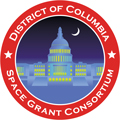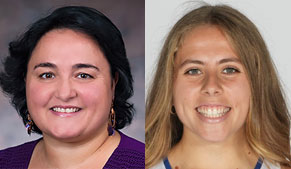Michael Bellacicco
I had the honor to work at NASA this summer with the Ocellus Team. Ocellus works on the 3D imaging LiDAR (Light Detection and Ranging) for APL/NASA’s Dragonfly mission, which is scheduled to launch in 2028. There, the rotorcraft (space helicopter/drone) will need the LiDAR system to image the landscape using its fast shooting lasers to know when and how to land to better collect scientific data. My internship was focused on helping mitigate a problem with one of the sensors, specifically the position sensing diode (PSD), within the LiDAR that was causing laser pointing error, and therefore incorrect measurements. Along with investigating the PSD error, I also had the opportunity to help assemble the ETU (Engineering Testing Unit) Front End Box of the LiDAR, where the PSD and other components reside. I regularly suited up to go into the clean rooms and wished I was clean shaven because of how itchy the mask was! But, as a Mechanical Engineer I could not help enjoying the sight of putting a bunch of beautifully machined parts together.
I also had some amazing NASA sponsored opportunities during my internship. My department, Code 551, specializes in optics. A few weeks into the internship, interns went on a tour of the Naval Observatory grounds and spoke with those who work on the atomic clocks…the ones that are the source for the USA’s time…pretty cool. We also got to see what used to be the largest telescope in the world! I also got a tour of the Hubble Control Center. There I was able to speak with one of the retired Hubble managers who would regularly work with Hubble after launch. Walking in the command center was like being in a movie with TVs and computers everywhere!
Most recently I was able to go into The Spacecraft Systems Development and Integration Facility (SSDIF), which is the largest clean room in the United States! The interns were able to see the flight parts for the Roman Space Telescope and speak with some of the engineers and technicians who have been working on it.
Overall, the things I have been able to see and touch this summer at NASA were pretty astounding. Taking part in this project has made a dream come true. My grandfather, Joseph Biagiotti, worked on the Landing Radar for the Lunar Module during the Apollo mission. Now, his grandson has gotten to work on a sort of landing “DAR” for another moon mission…nothing beats the smile on my grandmother's face.
I am so thankful to the DC Space Grant Consortium for their generosity. Without them, I would not have been able to have had an opportunity to take part in the future of space exploration.
Benjamin Kanzer
This summer, I was given the opportunity to work at the NASA Goddard Institute of Space Studies on their climate modeling team. The team at NASA GISS is working to develop a large-scale Earth system model (ESM), called ModelE, to aid in understanding changing climate regimes. Specifically, I worked on the fire (pyrE) team within ModelE. The pyrE module, embedded deep within the ESM, works to predict fire dynamics from a number of factors calculated by ModelE.
My work focused on reclassifying the manner in which the pyrE module calculates carbon emissions. Traditionally, the model calculated carbon emissions from fire count per grid cell. The work I did this summer attempted to reclassify emission calculations from burned area per grid cell rather than fire count. This new regime allows us to observe fire severity more substantially and provides more spatial data on which regions are being affected.
Overall, the experience was incredible, both for my development as a scientist and for my professional development. I was able to engage with a subject that I previously had no experience in, improve my coding abilities, and engage with scientists from all over the world. It was really stunning to see the number of scientists, from countless countries, working to improve ModelE for the purpose of advancing understanding of climate change. As a physics major, I definitely ran into some issues adapting myself to the world of atmospheric and climate science. I think this could be best described as differences in ideology. There were points in time when I was eager to dive into some minuscule point of conflict within the model that my advisor did not want to explore. I initially believed this was a symptom of the internship, specifically time constraints, but I later realized that it is indicative of the entire philosophy. ModelE has countless contributors, each doing their own work that will hopefully seamlessly work with every other contribution. Because of this, there are strict deadlines and standards that must be upheld. The scientists working on these teams are working on large-scale projects that are above themselves; it was very admirable.
I would like to thank the NASA DC Space Grant Consortium for giving me this opportunity to expand my scientific and professional prowess. Throughout my summer, I was able to expand my scientific prowess, as well as my professional skills. I would be unable to lend my hands—and brain, perhaps—to such a noble cause without the consortium, and I am deeply grateful for the opportunity.





